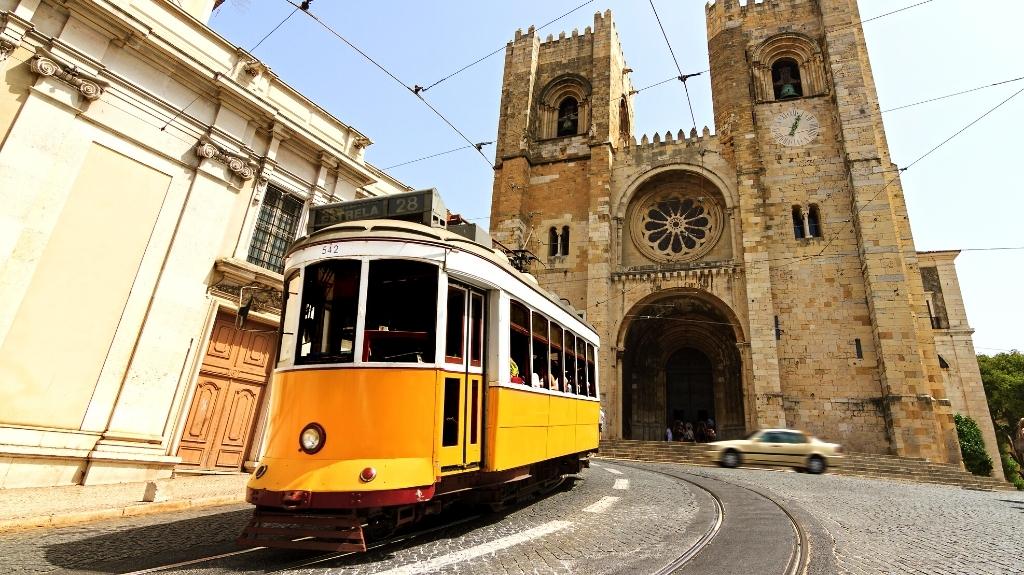
If you’re wondering whether to put the Portuguese capital on your travel wish list, let us tell you this:
Lisbon is worth visiting for its rich history, non-stop sunshine, jaw-dropping panoramas, and culinary delights. Travel to the city for the melodic fado music, the historic yellow trams, the Monument of the Discoveries, the vibrant ceramic tiles, and the narrow, steep streets of Alfama District.
Below, you’ll discover 33 cool reasons to visit Lisbon.
From the peculiar museums to the magnificent vistas, and from the mind-boggling monuments to the delectable beverages, we’re sure you’ll discover why it’s worth going to Lisbon.
Pack your sturdy shoes and let’s explore the charming streets of the Portuguese capital!
✅ Note: This article contains affiliate links. In case you purchase something through one of these links, we may receive a small commission at no extra cost to you. Thank you for helping us keep creating the free content on this website!
The Attractions That Make Lisbon Worth Visiting

Ancient fortifications, awe-inspiring monuments, and intricate edifices will fight for your attention in the city on the Tagus River. In this section, you’ll explore the top attractions that make Lisbon worth visiting.
- Belém Tower. Also known as the Tower of Saint Vincent, Belém Tower was built in the 16th century. The medieval fortification rises on a small island in the Tagus River. One of the tower’s functions was as a ceremonial gateway to Lisbon. From this spot, the fearless Portuguese explorers embarked on their adventures. When in Lisbon, visit the rooftop terrace of the tower. From there, you can enjoy the majestic views of the Tagus River’s estuary.
- Padrão dos Descobrimentos. Lisbon is famous for initiating the Age of Discoveries. The Monument of the Discoveries celebrates Portuguese maritime explorations. The landmark is shaped like a ship’s stem. A statue of Henry the Navigator adorns its front. Another 33 important historical figures from the Age of Discovery stand behind him. The group consists of prominent monarchs, scientists, explorers, artists, and cartographers. The massive landmark raises 171 ft. (52 m) high on the north bank of the Tagus River.
- Sanctuary of Christ the King. An imposing monument inspired by Rio de Janeiro’s “Christ the Redeemer” overlooks the city of Lisbon. Standing on a hill in the Almada District, Christ the King rises above the Portuguese capital, facing the left bank of the Tagus River. The 92-ft. (28-m) tall sculpture of Jesus stands on a huge pedestal. You can visit the observation deck at the base of the statue. From there, admire the jaw-dropping scenes of Lisbon, the Tagus River, and the 25 de Abril Bridge.
- Castelo de São Jorge. Revealing arguably the best panorama of Lisbon’s historic center and the Tagus River, São Jorge Castle is a stunning Moorish fortress. Several defensive structures have existed on its spot since the 1st century BC. The current fortification dates back to the 11th century. About a century after it was built, it started serving as a royal residence. Today, the palace ruins and the onsite archaeological museum are some of the landmarks that make Lisbon worth visiting.
- Lisbon Cathedral. The most important church in the Portuguese capital is Sé de Lisboa, also known as the Cathedral of Saint Mary Major. The edifice from the 12th century has the shape of a Latin cross. The main façade resembles a fortress, while two towers flank the entrance. A series of windows bring the sun to the interior. Several earthquakes destroyed the Lisbon Cathedral over the centuries, but it was always rebuilt. This resulted in the cathedral’s unparalleled mix of architectural styles.
- Jerónimos Monastery. The Hieronymites Monastery represents the Portuguese Late Gothic Manueline architectural style. The UNESCO World Heritage Site stands in the Belém District. It took the builders 100 years to complete the renowned architectural masterpiece. The monastery boasts complex ornaments, which include maritime elements and items discovered during naval expeditions. An archaeology and a maritime museum occupy the monastery’s wings.

- Arco da Rua Augusta. The ornate triumphal Arco da Rua Augusta was built in 1875. The stone structure marks the beginning of Lisbon’s main pedestrian street, Rua Augusta. Six columns support the arch. In the middle of the structure, you’ll see the Portuguese coat of arms. Delicate sculptures of historical and mythological figures cover the arc’s façade. For a small fee, you can climb to the top and admire the stunning vistas of the area.
- Elevador de Santa Justa. The Santa Justa Elevator is one of the most unusual attractions of Lisbon. Operational since 1899, the cast-iron lift consists of a metal tower, an observation platform, a walkway, and a base. The tower features two elevator cabins. Each of them can transport up to 29 people and offers great views of the historic center. The elevator is 148 ft. (45 m) high and has seven floors. It boasts intricate ornaments and connects the lower streets with the higher-standing Largo do Carmo.
- Oceanário de Lisboa. The aquarium prides itself on the largest tank in Europe, holding an impressive 5 million liters (1.3 million gallons) of water. The Lisbon Oceanarium is home to cute penguins, funny tropical fish, stealth stingrays, and scary sharks. You’ll find the aquarium’s modern building on the waterfront, on the exhibition grounds of Expo 1998. You can’t miss the impressive edifice. It looks like an airplane landed on a dock in the middle of an artificial lake.
- Ponte 25 de Abril. Often compared to the Golden Gate Bridge, the striking Ponte 25 de Abril spans over the Tagus River for more than 1.4 mi (2.3 km). The impressive red suspension bridge connects the historic center of Lisbon with the Almada District. Note that it’s illegal to walk on the bridge. To cross it, take a tram or a bus instead. However, the most spectacular and unforgettable way to marvel at Ponte 25 de Abril is to arrive in Lisbon by ship.
- Ponte Vasco da Gama. Another striking structure over the Tagus River is Ponte Vasco da Gama, Europe’s second-longest bridge. The impressive 7.67-mi (12.35-km) long cable-stayed construction has six lanes, where drivers can speed up to 75 mph (120 km/h). Viaducts flank the bridge’s sides. Construction began in 1995 and finished just in time for Expo 98. The world exposition celebrated the 500th anniversary of Vasco da Gama’s discovery of the sea route from Europe to India.
- The National Museum of Ancient Art. In the heart of Lisbon, you’ll find one of Portugal’s largest collections of ancient art. Museu Nacional de Arte Antiga displays works from the 12th to the 19th centuries, which include pieces by the famous Portuguese artists Nuno Gonçalves and Francisco de Holanda. Next to paintings, you can marvel at sculptures, ceramics, metalwork, textiles, and furniture from different artistic movements. Gothic, Baroque, Renaissance, and Rococo styles are represented in the museum. Don’t miss the serene garden, where you can enjoy a coffee or a snack among gorgeous statues.
Visit Lisbon for the Scrumptious Foods and Drinks

One of the most enjoyable ways to experience the bustling Portuguese capital is by indulging in its delicious flavors. Discover which staple foods and drinks Lisbon is worth visiting for below or during this food&wine walking tour.
- Bifana. The traditional Lisboan sandwich bifana embodies thinly sliced pork inside a hearty bread roll, with a splash of spicy piri piri sauce or mustard. The highlight of this simple trio is the slowly cooked meat. Before joining the bifana, it has simmered for hours in a fragrant marinade of white wine, garlic, and herbs. If you’re a meat lover, you’ll lick your fingers after tasting it.
- Chouriço. The authentic Portuguese smoked sausage is to die for. Pork and fat are flavored with garlic, cumin, cinnamon, white pepper, and piri piri peppers. In Lisbon, you’ll find chouriço in many varieties, either on its own or in hefty stews. We recommend you try it as chouriço assado. This dish is prepared directly on your table, over an alcohol flame, in a burning clay pot. It’s both spectacular and heavenly delicious.
- Feijoada. This traditional bean stew incorporates a variety of meats, garlic, and onions. Smoked pork sausage, pork belly, pork shoulder, and beef usually join in the pot. The beans and meats simmer together until they become tender and soft. Rice, collard greens, and orange slices typically accompany feijoada. The Portuguese enjoy the hearty, flavorful dish on special occasions as a traditional family meal.
- Sardinhas. Grilled or canned, ordering sardines in Lisbon is a must. From the grill, sardines come drenched in olive oil. You can order the scrumptious dish in almost any eatery in the Portuguese capital. You’ll find vibrant cans in countless shops all around the city. Note that the price varies greatly. The most exquisite cans might cost as much as €100 ($109)!

- Bacalhau. In Lisbon, you can sample codfish, prepared in 365 different ways. That’s how obsessed the Portuguese are with bacalhau. Peculiarly, it used to be the staple food during the explorations of the Portuguese sailors. In the Age of Discovery, they needed products that would preserve well during long journeys. Dried and salted codfish were perfect for this. Nowadays, we recommend trying bacalhau à brás and pataniscas de bacalhau. They’ll make you fall in love with codfish.
- Pastéis de Nata. The godly custard tarts are crunchy on the outside and creamy on the inside. You can order the egg-cream scrumptiousness in every café, bakery, and pastry shop in Portugal. The pastry’s recipe is one of the most strictly kept secrets in the country. In some versions, apples or other fruits are added to the cream. The best places to satiate your sweet tooth cravings in Lisbon are Fábrica da Nata, Alfama Doce, and Manteigaria.
- Ginjinha. The name of this popular Portuguese liqueur comes from ginja berries. They’re a sour cherry variety, which has been infused with alcohol to produce this signature drink. Sugar, cloves, and cinnamon further enhance the berries’ flavor. In Lisbon, you’ll find specialty bars, which serve exclusively ginjinha. The most famous ones include the traditional To Ginjinha, the unusual Ginjinha das Gáveas, and the colorful Ginjinha Sem Rival.
- The local wines. Lisbon is a prime destination for wine enthusiasts, as it is the epicenter of Portuguese winemaking. The region offers a diverse selection of tasty white, red, and rosé wines. To fully experience the wine culture of the city, visit one of the cozy wine bars scattered throughout Lisbon. Our recommendations include Fado & Wine and Antiga Wine Bar. For a more in-depth exploration of Lisbon wines, join a day trip to a local wine cellar and vineyard.
Go to Lisbon for the Unique Experiences

From peculiar vehicles to exclusive souvenirs, you can have many unique experiences in Lisbon. Let’s find out what creates the Portuguese capital’s unparalleled atmosphere.
- The fado locales. Literally meaning “fate”, the most popular Portuguese music originates from Lisbon and the region. You can learn about its roots at Museu do Fado. But to truly experience the unique melody and singing, visit one of the countless establishments hosting live concerts. The most popular fado locales in Lisbon include Sr. Fado, Fado & Wine, and Duque da Rua. Alternatively, you can book the unforgettable “Fado in Chiado” show via this link.
- Tram 28. The iconic yellow tram will take you on a scenic tour around the historic districts of Lisbon. The famous line 28 dates back to 1914. The small bright tramcars climb the steep hills and take the sharp curves with ease. Unfortunately, due to their popularity, the historic trams may get overcrowded. Our recommendation is to take line 12 instead. It receives fewer passengers and also loops around the city center.
- Tuk-Tuks. The little vehicles, which are typical of South-East Asia, are a great fit for the steep, narrow streets of Lisbon as well. You’ll see them parked at every corner of the historic center, ready to take you on an exhilarating adventure around tight corners and sharp hills. You can even book one in advance to explore the cobbled alleys of the Portuguese capital in an unusual manner. Usually, you pay by the hour and the driver becomes your own tour guide.
- Cork. Around half of the world’s cork is harvested in Portugal. The versatile material comes from the bark of a species of oak. One of the coolest Lisbon facts is that the city boasts countless souvenir shops and boutiques selling products from high-quality cork. The material is lightweight and waterproof, plus it’s an excellent insulator. The selection of trendy bags, unique purses, modern belts, fashionable jackets, and eye-catching jewelry made of this natural product will amaze you.
- The Portuguese Riviera. One of the easiest day trips from Lisbon is to the Portuguese Riviera. At the western border of Lisbon’s metro area, you can enjoy some beach time at the Atlantic Ocean coast. The best sand stretches to visit are Praia da Crismina and Praia do Guincho. The latter is famous among surfers, and it featured in a James Bond movie. The Portuguese Riviera is home to the westernmost point of Continental Europe as well. The rugged cliffs of Cabo da Roca are worth the trip from Lisbon.
- Azulejos. Walking around Lisbon, you’ll encounter many buildings covered in colorful ceramic tiles. In Portuguese, they’re called azulejos. They decorate murals, townhouses, and metro stations. Azulejos usually feature an enchanting story, a biblical tale, or an epic adventure. You’ll find the most impressive azulejos at Fronteira Palace, the Monastery of São Vicente de Fora, and Jardim da Quinta dos Azulejos. And at Museu Nacional do Azulejo, you can learn about their production, as well as admire incredible azulejos displays.
- Bairro Alto. One of the city’s most intriguing historic neighborhoods to explore is the Upper District of Lisbon. Walk around the steep cobbled streets of Bairro Alto or ride the historic funicular. Marvel at the centuries-old colorful houses and enjoy the vibrant street murals. Immerse yourself in the romantic atmosphere and enjoy the panoramas from the breathtaking viewpoints. In the evening, go for drinks in the quirky ginjinha bars or see a concert in the cozy fado locales around the neighborhood.

- Alfama. You’ll find some of Lisbon’s most popular attractions in Alfama District. Ride the historic Tram 28 uphill to avoid climbing the steep streets, and explore Lisbon Cathedral and São Jorge Castle. The most magnificent views over Lisbon unravel from the castle. After you’ve feasted your eyes on the vistas, get lost in the cobbled alleys of Alfama. Souvenir shops, selling traditional crafts, and cute cafés, serving delicious pastries, dot the streets of the neighborhood. The sound of melancholy fado songs satiates the evening air.
- Praça do Comércio. The Commerce Square of Lisbon faces the water and greets travelers who arrive by sea. It’s one of the largest plazas in Portugal. The last redesign of the square was in the 18th century after an earthquake destroyed most of the buildings around it. In the middle of the plaza rises the grandiose equestrian statue of Joseph I of Portugal. Several important cultural centers surround the square. We recommend visiting the Lisboa Story Centre. Inside, you’ll learn the history of Lisbon and the conquests of the Portuguese explorers through fun interactive displays.
- Rua Augusta. The most famous pedestrian street in Lisbon starts near the Praça do Comércio. Beginning at the Arco da Rua Augusta, Rua Augusta stretches for about half a mile. Elaborate, vibrant mosaics pave the alley. Bars, restaurants, cafés, pastry shops, boutiques, and hotels line its sides. Enjoy a coffee with a traditional pastel de nata, sample the local drink ginjinha, or order a port wine. Shop for exquisite cork products or hunt for new fashion designs in the boutiques along Rua Augusta.
- Parque Eduardo VII. The large public park was inaugurated in 1902, in honor of King Edward VII of the United Kingdom, and is one of the most popular recreational spaces in Lisbon. Parque Eduardo VII features manicured gardens and an observation deck that offers staggering scenes of the city. You can walk around the tree-lined alleys, admiring the bronze statues, exotic plants, and pavilions. Don’t miss the charming pond and the views of the sea in the distance. The park also hosts diverse cultural events and concerts throughout the year.
- The viewpoints. The hilly terrain of Lisbon offers unique vantage points with breathtaking panoramas throughout the city. The most visited viewpoints include Miradouro das Portas do Sol, Miradouro do Castelo de São Jorge, and Miradouro de Santa Luzia. The spot at Portas do Sol provides a picturesque view of the red-roofed houses and stone churches of Alfama. The vantage point at São Jorge Castle offers sweeping vistas of the historic center and the ocean. And Santa Luzia’s observation deck enchants with a panorama of Lisbon and the Tagus River.
- The markets. To best immerse in Lisbon’s unique vibe, wander the city markets. The most popular ones are:
- Mercado da Baixa. An open-air market, offering traditional street food, refreshing beverages, and local produce. The friendly merchants will invite you to taste their scrumptious smoked meats, dried fruits, and delectable sweets.
- Mercado da Figueira. The indoor complex of stalls and small shops seduces with fresh produce, local wines, and fragrant spices. Your senses will love the exotic fruits, fresh meat, and the abundance of pastries you’ll encounter while walking around.
- Mercado da Ribeira. You’ll find anything from scrumptious food through live plants to books and antiquities in this large indoor market. So, whether you decide to go on a treasure hunt or a sampling spree, you’ll have a blast.
- Mercado de Santa Clara. The flea market at Campo de Santa Clara is another Lisboan treasure trove. Twice a week, you can dig through a diverse blend of clothes, household items, and antique relics to find what strikes your fancy.
Now You Know Why Lisbon Is Worth Visiting

This wraps up our top 33 reasons to visit Lisbon.
The lively capital of Portugal will steal your heart with its unforgettable scenes, delectable cuisine, majestic monuments, and colorful streets.
To make your trip even better, don’t forget to read our Lisbon travel tips.
Now, we’d like to know:
In your experience, is Lisbon fun to visit?
Share with us in the comments below.






